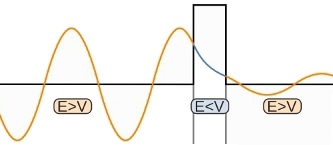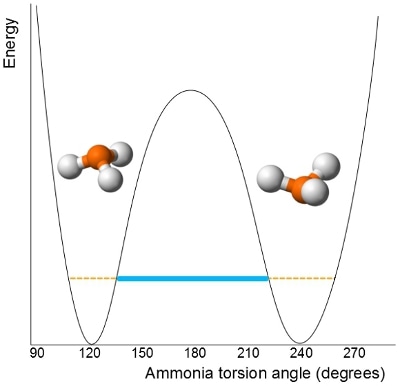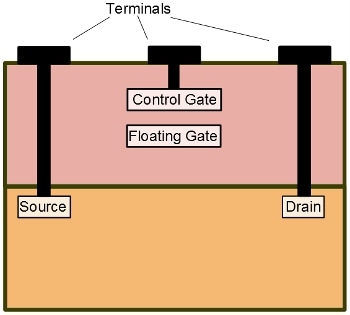May 15 2012
The quantum tunneling effect is a quantum phenomenon which occurs when particles move through a barrier that, according to the theories of classical physics, should be impossible to move through. The barrier may be a physically impassable medium, such as an insulator or a vacuum, or a region of high potential energy.
In classical mechanics, when a particle has insufficient energy, it would not be able to overcome a potential barrier. In the quantum world, however, particles can often behave like waves. On encountering a barrier, a quantum wave will not end abruptly; rather, its amplitude will decrease exponentially. This drop in amplitude corresponds to a drop in the probability of finding a particle further into the barrier. If the barrier is thin enough, then the amplitude may be non-zero on the other side. This would imply that there is a finite probability that some of the particles will tunnel through the barrier.

In regions where the potential energy is higher than the wave's energy, the amplitude of the wave decays exponentially. If the region is narrow enough, the wave can have a non-zero amplitude on the other side. Image Credits: Wikipedia
The tunneling current is defined as the ratio of the current density emerging from the barrier divided by the current density incident on the barrier. If this transmission coefficient across the barrier is a non-zero value, then there is a finite likelihood of a particle tunneling through the barrier.
Discovery of Quantum Tunneling
The possibility of tunneling was first noticed by F. Hund in 1927, while calculating the ground state energy in a "double-well" potential—a system where two separate states of similar energies are separated by a potential barrier. Many molecules, such as ammonia, are examples of this type of system. "Inversion" transitions between two geometric states are forbidden by classical mechanics but are made possible by quantum tunneling.
In the same year, L. Nordheim noticed another incidence of the tunneling phenomenon while studying the reflection of electrons from a variety of surfaces. In the next few years, Oppenheimer successfully used tunneling to calculate the ionization rate of hydrogen. Meanwhile, studies by Garnow, as well as Gurney and Condon, explained the range of alpha decay rates of radioactive nuclei.

The two energetically equivalent states of ammonia, NH3, can exchange more readily than is classically predicted - this is because the molecule can tunnel through the potential barrier at lower energies than are required to pass through the transition state.
Quantum Tunneling in Nature
Similar to quantum physics, tunneling may appear to have little relevance to everyday life but, it is a fundamental process of nature which is responsible for many things on which life itself is dependent. It has even been hypothesized that the very beginning of the universe was caused by a tunneling event, allowing the universe to pass from a "state of no geometry" (no space or time) to a state in which space, time, matter, and life could exist.
Tunneling in Stellar Fusion
Fusion is the process by which small nuclei can join together to form a larger nuclei, releasing huge amounts of energy. Fusion inside stars produces all the elements of the periodic table, except hydrogen. The fusion of hydrogen into helium is the process which gives stars their power.
Fusion occurs much more often than what was originally thought. As all nuclei are positively charged, they repel each other very strongly, and their kinetic energy is very rarely sufficient to overcome such repulsion and allow fusion to occur. If tunneling effects are taken into account, however, the proportion of hydrogen nuclei which are able to undergo fusion increases dramatically. This phenomenon helps to explain how stars are able to remain stable for millions of years. The process, however, is still not fully supported by science, as an average hydrogen nucleus will undergo over 1000 head-on collisions before it fuses with another.
Tunneling in Smell Receptors
It was initially believed that chemical receptors in the nose (400 different kinds in humans) detected the presence of various chemicals by a lock-and-key process which identified the molecule's physical shape; however, more recent studies found problems with such theory. For example, ethanol and ethanethiol, which have very similar shapes, smell completely different (ethanol is the alcohol that humans drink, while ethanethiol smells of rotten eggs). This suggests that some other identifying mechanism is at work.
The theory is that smell receptors rely, in part, on quantum tunneling to identify chemicals. The receptors pump a small current across the odorant molecule, causing it to vibrate in a characteristic way. In order for the current to flow, however, the electrons must tunnel through the non-conducting gap between the cells of the receptor and the molecule. New experiments on quantum tunneling utilized large hydrogen and deuterium bonds to facilitate olfactory reactions to stimuli. The results showed increased quantum vibrations, suggesting that humans are capable of differentiating between molecules with quantum vibrational signatures.

Smell receptors can detect the differences between similarly-shaped molecules by tunneling a small current across them, causing a characteristic vibration.
Applications of Quantum Tunneling
Josephson Junctions
Josephson junctions consist of two superconductors separated by a very thin layer of non-superconducting material, which can be an insulator, a non-superconducting metal, or a physical defect. The superconducting current can tunnel across the barrier, and the electrical properties of this system are very precisely defined.
This leads to several unique applications, primarily for highly precise measurements. Josephson junctions are common components in superconducting electronics, quantum computers, and are also used extensively in superconducting quantum interference devices (SQUIDs), which are capable of measuring extremely weak magnetic fields. These junctions are also being studied as a means to measure quantum coherence.
Tunnel Diodes
A tunnel diode is a semiconductor capable of high speed operation, comprising of a thin insulator sandwiched between two semiconductors. Also known as the Esaki diode after L. Esaki for his work on the topic, this diode is capable of frequencies well into the microwave range.
Tunnel diodes are a two-terminal device with a heavily doped p-n junction where the electric current through the diode is caused by quantum tunneling. Significantly, the current across the tunnel diode will decrease as the voltage increases. As an effect, the tunnel diode will exhibit a negative resistance. The concentration of impurities in a tunnel diode is 1000 times greater than a normal p-n junction diode. As a result, the p-n junction has an extremely narrow depletion region in the order of nanometers. In ordinary diodes, current is produced when an applied voltage is greater than the built-in voltage of the depletion region.
In tunnel diodes, a small voltage that is less than the built-in voltage of the depletion region produces an electric current due to quantum tunneling between the n and p region. The narrow depletion region is required so that the barrier thickness is low enough for tunneling.
Tunnel diodes are used in logic memory storage devices, relaxation oscillator circuits, and as ultra-high-speed switches. Owing to the high resistance to radiation, they are commonly-used in the nuclear industry.
Scanning Tunneling Microscopes
A Scanning Tunneling Microscope (STM) works by scanning a very sharp conducting probe across the surface of a material. An electrical current is passed down the tip of the probe, and it tunnels across the gap into the material.
As the gap gets wider or narrower, the tunneling current gets smaller or larger, respectively. Using this data, an incredibly detailed picture of the surface, even to the point of resolving humps in the surface due to individual atoms, could be built. This technique has allowed a greater understanding of the physics and chemistry of surfaces.

Schematic of an STM - the tunneling current varies with the distance between the tip and the atoms on the surface, allowing defects and even individual atoms to be mapped.
Flash Drives
Data on flash drives is stored in a network of memory cells made up of "floating-gate" transistors. These consist of two metal gates, a control gate, and a floating gate. The floating gate is trapped in an insulating layer of metal oxide.
A floating-gate transistor in its normal state registers a "1" in binary code. When an electron is attached to the floating gate, it becomes trapped in the oxide layer, affecting a change in the voltage of the control gate. A transistor in such state registers a "0" in binary.
When data is erased from flash memory, a strong positive charge applied to the control gate causes the trapped electron to tunnel through the insulating layer, returning the memory cell to a "1" state.

Schematic of a floating-gate transistor. Trapping an electron in the floating gate causes a change in the voltage across the control gate. Each transitor stores a bit of information.
Sources and Further Reading
This article was updated on the 3rd January, 2019.